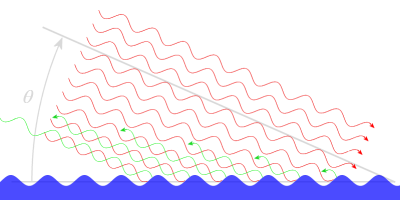Bragg-Scattering

Figure 1: Under certain conditions, weak individual reflections can add up to a significant echo signal with constructive interference. A short transmit pulse is in this case, however, stretched considerably.

Figure 1: Under certain conditions, weak individual reflections can add up to a significant echo signal with constructive interference. A short transmit pulse is in this case, however, stretched considerably.
What is bragg scattering?
Bragg-Scattering
The Bragg-Scattering explains the effects of the reflection of electromagnetic waves on periodic structures whose distances are in the range of wavelength. The phenomenon was investigated in 1912 by William Lawrence Bragg and William Henry Bragg with X-rays and their reflection in crystal lattices. The periodic structures of reflective surfaces or volumes can be investigated with the much larger wavelength used in radar devices.
In certain wavelengths regular periodic structures with a constant distance there-between, allow a coherent superposition of reflections from the faces and thus constructive and destructive interference Destructive interferences are here quite meaningless. Constructive interference can strongly reinforce the echo signals in the direction of the radar receiver. This constructive interference occurs in a certain ratio between the transmitted wavelength and the distance of the reflective sub-surfaces:
| d = | λt | mit |
d = distance of the reflective sub-surfaces λt = transmitted wavelength θ = incident angle (also-called “Bragg angle” here) |
(1) |
| 2· cos θ |
With variable transmission frequency can thus be measured the distance between these regular structures. This effect is used to measure, for example, the height of the waves (wave spacing, the waves direction of propagation, and thus wind direction) away from the coast using extremely long wavelength radar. The propagation of the electromagnetic wave is parallel to the sea surface, the incident angle θ is here thus zero degrees. This simplifies the equation (1). At each wave crest a small fraction of the transmitted energy is diffracted and reflected by the next wave crest. At a frequency of the transmitter of 5 MHz, the electromagnetic wave has a wavelength of 60 m; a constructive interference can occur in a sea state with waves at a distance of 30 m. A practical example is the WERA- Radar, which operates in the HF-Band and displays the sea state up to a distance of 250 km off the coast. But this effect occurs also in radars, which are used in satellites.
In weather radar, the Bragg scattering is exploited in so-called wind profilers. The regular structures are produced here synthetic by large loudspeakers. Upwardly directed sound waves (longitudinal waves) generate depending on the acoustic frequency ranges of different air density. Whose distances to each other are dependent on the acoustic wavelength, in this case of the (known) frequency and the (yet) unknown propagation speed which is dependent on the average density of the air layers. At these inhomogeneities a small part of the transmitting energy is reflected in each case. With the radar principle is now registered the Bragg reflection at the regular intervals of the density modulation produced by the sound. (The propagation speed of the electromagnetic waves can be assumed to be constant in the considered area.) Since the air temperature also affects the density of the air and hence the acoustic wavelength, even temperature differences between the air layers can be measured indirectly.
In airspace surveillance radars this effect becomes more disturbing. Random sequences of inhomogeneities in the air density can produce so-called Clear-Air-Echos. These are referred to as “angels” and may cause false alarms.
